
|

|
|
Home Site Search Contact Us Subscribe
|
|
"Five Artists + Architecture" at the Spitzer School of Architecture, City College of New York The variety of works by the five fine artists/teachers illustrates the breadth of opportunity available to students to integrate a range of visual arts studies into their studio design education and design research work. By Lance Jay Brown, FAIA February 1, 2018 “Five Artists + Architecture” is an exhibition of paintings, sculpture, and photography celebrating the works of Alan Feigenberg, Daniel Hauben, David Judelson, Irma Ostroff, and Albert Vercerka. All have been teaching for decades at the Bernard and Anne Spitzer School of Architecture at the City College of New York.
Since its founding in 1969, the school has always offered students the opportunity to integrate a wide range of visual arts studies into their studio design education and design research work. Inclusion and diversity are integral to the school. This is reflected in the cultures and languages of both the students and faculty. This is also true of the variety of works by the five fine artists represented that illustrate the breadth of opportunity available to the students.
The artists presented continue the tradition of their predecessors (Anthony Candido, Leo Lionni, Gabriele Roos, et al.) by adding the tools, techniques, and sensibility of their endeavors, their art, and their craft to the student experience and working vocabulary.
Underscoring the importance of the artist/teacher contribution, Joan Ockman, senior lecturer at the University of Pennsylvania School of Design and editor of Architecture School: Three Centuries of Educating Architects in North America (MIT Press, 2012), said in notes accompanying the exhibition: "While the artist is no doubt more of a rara avis on the architecture faculty today, especially since the advent of the computer, she or he remains a deeply valued presence in the school, bringing much-needed aesthetic sensibility and an inspirational point of view to an ever-more pragmatic discipline."
Ockman’s comment begs the question of how people are to be educated for professional engagement as we move deeper into an ever more technologically-oriented 21st century. It is clear that most everything we currently engage is facing a paradigm shift. To what extent core principles, values, concepts, and methods survive is part of our time’s ethical challenges.
“Five Artists + Architecture” is on view in the Atrium Gallery in the school’s building designed by Rafael Viñoly (completed in 2009). It will run through February 16, 2018, with a Gallery Talk with the artists and visitors on Thursday, February 15, 12:00-2:00pm, and a closing panel discussion with the artists and curator at 6:00-8:00pm on Friday, February 16th.
Lance Jay Brown, FAIA, curator of “Five Artists + Architecture, is principal of Lance Jay Brown Architecture + Urban Design, and an ACSA Distinguished Professor, Bernard and Anne Spitzer School of Architecture, City College of New York. Lbrown@ccny.cuny.edu
The Artists
Alan Feigenberg
I strive to be an architect, an environmental psychologist, a union and political activist, a photographer, an educational facilitator, and...
As an architect, I see a priority and commitment to develop functional as well as visually enticing buildings and spaces, and also seeing the importance and grandeur of the incredible construction workers who are entrusted to understand the architecture and make it a 4-dimensional human reality.
I hope that my work, my teaching, my activities, my life stimulates people to: * look & relook * question & re-question * critique & re-critique * label & re-label * consider & re-consider...
Daniel Hauben
Painting the Urban Landscape: Born and raised in The Bronx, I am a product of the urban environment. The city was, and still remains for me, a world full of wonder and mystery.
In my artistic examination of this chaotic landscape, I seek to distill an underlying logic and pattern. Sometimes exhilarating, sometimes perplexing, the urban environment has proven a formidable and captivating focus of my art for more than four decades.
David Judelson
I taught first year design as an adjunct assistant professor for 15 years and the summer architectural program for College Now for 12 ( I describe my teaching career as a 15 year love affair); retired from active teaching but maintain working relationships with many former students.
I am currently working on the development of large scale constructions, living at the intersection of art and architecture, which will enhance public spaces, make richer the thresholds of buildings and promote social interaction. The work in this exhibition, some free-standing, some wall-mounted and others suspended, span a period from 1995 (older and iconic) to the present (complex and experimental).
Irma Ostroff
Teaching: By careful observation and analysis of the visual field, students develop and refine visual and spatial acuity. They explore various freehand approaches to line, form, mass, and composition, with emphasis on the expression of volume and the effects of light and color within a pictorial context. Color theory, often neglected in undergraduate architectural education, is investigated through practice. Experience in drawing by hand teaches a direct pathway to the expression of ideas, which will inform and enhance work done on the computer. To expand a student’s visual vocabulary increases his/her expressive possibilities, both practically and aesthetically, as he/she becomes an effective visual communicator.
Recent work: This is a body of work luxuriating in color relationships, compelling and complex; where the juxtaposition of domestic references and built forms, organic and planned, male and female, are at work, appearing and disappearing in the process. Clearly, I have been influenced by architects and architecture, offset by a barely contained conflict between order and disorder.
Albert Vercerka
As an artist, I look for visual cues and elements and try to assemble them in a composition just as a writer would compose a sentence or a paragraph. Looking for the right light, right day, or right time of day is a part of that narrative. I carefully observe and allow events to unfold in front of the camera.
I emphasize the same principles with my students. We look at photography as a visual communication tool that is useful in many stages of architecture. From improving their rendering skills through understanding of photography principles, to better pictures of their sites and process, and finally to improved photography of finished buildings. I ask them to carefully observe the subject, pay close attention to their acquired knowledge of photography, look at the light, and tirelessly refine and edit their work. It seems that our tolerance for bad visuals is greater then our tolerance for bad sound in video, or for inadequate writing. My goal is to increase the standard for photographic visual communication.
|
(click on pictures to enlarge) 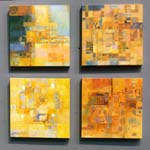 İLance Jay Brown Irma Ostroff: Untitled, 2015-16; oil on linen; 20" x 20" each 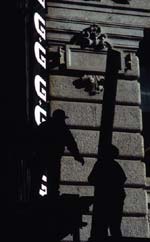 İAlan Feigenberg Alan Feigenberg: “Silhouettes”; print from .jpg; 11" x 14" 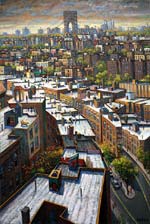 İDaniel Hauben Daniel Hauben: “Canyon in the Heights”; oil on canvas, 36" x 24" 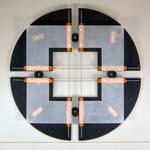 İDavid Judelson David Judelson: "Quadrants 5 (Pan Liang)," 2009; a series of seven wall-hung sculptures constructed of sanded Plexiglas, wood, rubber, and hardware, each about four feet in diameter. 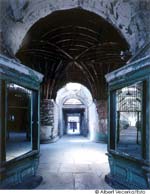 İAlbert Vecerka/Esto Albert Vecerka: “Mirrors, Cell blocks 8 and 9”; 72” x 96” (6x8 feet); from Eastern State Penitentiary series, 1999-2002; C-print from a 4X5 negative 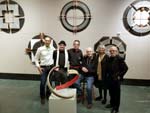 İSolomon Oh Five artists and the curator in front of Judleson's "Quadrants" (l-r): Albert Vecerka, Daniel Hauben, Alan Feigenberg, David Judelson, Irma Ostroff, and Lance Jay Brown. |
İ 2018 ArchNewsNow.com